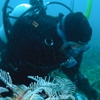General Description
Colony of individual polyps (hydranths) joined by root-like network of tubular stolons at the base. Colony shape is simple stems. Colour: colonies transparent white, gonophores cream. Up to 3 mm high.
Biology
This is a common species in southern Australia. Colonies grow annually and are fertile in spring and summer.
Habitat
On fronds of brown algae and invertebrates in moderate shelter.
Reefs
Distribution guide
Southern Australia.
Species Group
Depth
Water Column
Max Size
3 mm
Diet
Plankton or Particles
Harmful
Generally not harmful but still able to sting bare skin.
Commercial Species
No
Species Code
MoV 3455
Identify
Conservation Status
- DSE Advisory List : Not listed
- EPBC Act 1999 : Not listed
- IUCN Red List : Not listed





